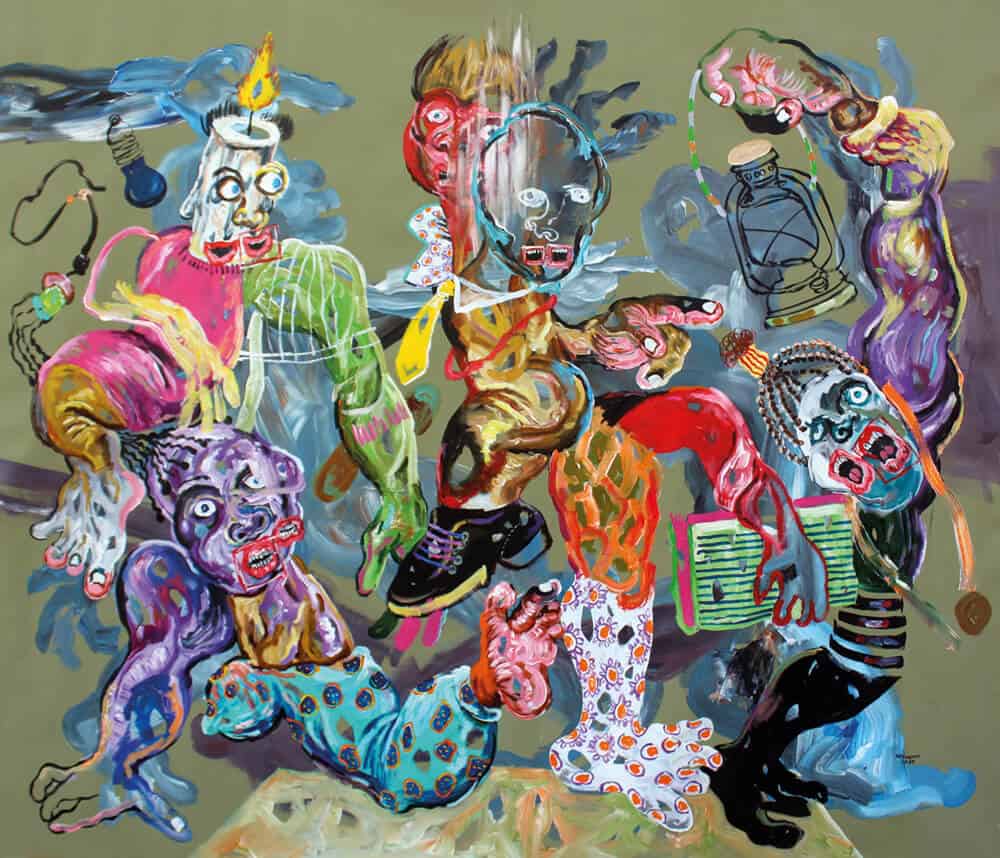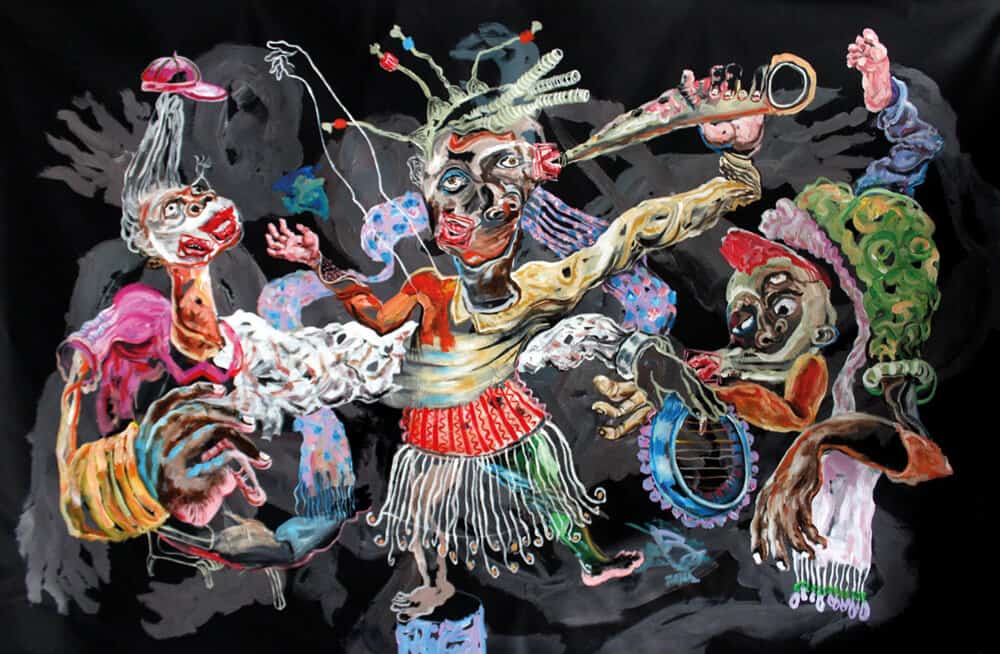Cristiano Mangovo captures social relations with a surrealistic twist

Cristiano Mangovo, Uanhenga Xito. Oil on canvas, 160 x 120cm. Image courtesy of the artist & This Is Not a White Cube.
ART AFRICA spoke to painter Cristiano Mangovo, who was represented by Angolan gallery This Is Not A White Cube at ARCOlisboa this year. Art is his platform for reflecting on the social issues spurred on by power imbalances in Africa and the world at large. Before the blank canvas he admits to feeling like “a little god” – experimental and spontaneous.
ART AFRICA: You draw on numerous social issues – such as the protection of the environment and women’s rights – as inspiration for your work. Could you tell us more about how this social context appears in your work?
Cristiano Mangovo: As I began to understand the indifference and inequalities that exist in African societies and in the world, this social context started to appear in my work. In war-ravaged conflict zones, the most fragile human beings suffer the most. Women are sexually assaulted, and children are taken to military activities. Even after the formal ending of war this still exists, just in another way. Nowadays we are facing a huge migration crisis that is also a consequence of this conflict between the strongest and most fragile human beings. When we make a comparison between humans and environment, human beings are the first to find themselves the most powerful, to take advantage of the environment and to pollute, through our consumption, hunting, the torture of trapped animals in zoos, and the extermination of green areas. I am concerned with these ideas and questions. I ask myself, ‘When will all this end?’ This particular question is a driving element that underpins my artistic goals.
Your work has a unique aesthetic, forged through thick layers of paint and the presence of bodies that connect to larger issues – could you elaborate on this?
I think aesthetics is one of the most important components that I like to develop in my work. Beautiful things easily captivate my attention. When I am in front of a canvas, my desire is to enhance the beauty that my eyes have recorded, which I imbue together with my inner beauty. The act of painting is like a magical moment – and at the same time it is a therapy for me. It makes me feel like a little god. I like to feel the weight of the layers of paint on the tip of my brush striking the canvas. In this way I feel like I’m making the best out of those moments of creativity. What I observe, I move it to painting in a very personal way. I do it freely, without worrying about whether anyone on the planet likes it or not. When I paint, I wish to feel like a true God who creates his own world in complete freedom. I don’t feel as comfortable in front of a small canvas as I do in front of a larger one. I need to feel that I have enough space to release my inspiration and then it flows like the wind in the morning.
 Cristiano Mangovo, Alternativo, 2019. Acrylic on canvas, 160 x 180cm. Courtesy of the artist & This Is Not a White Cube.
Cristiano Mangovo, Alternativo, 2019. Acrylic on canvas, 160 x 180cm. Courtesy of the artist & This Is Not a White Cube.
Your paintings are also known for their evocative use of bright colours – what does this use of colour represent to you?
The use of bright colours is related to a specific part of my life. I grew up in the city, but as a child I spent a lot of time in the countryside. This was a time that greatly impacted my life. Every day I would see the sunrise and sunset, with all those yellow, orange, and red colours. I would breathe the scent of the bush, seeing the green colours of the forest and enjoying the multiple changes in the colour of the sky. I would play and dance at night in the light of the moon and the fire. These are the beautiful and colourful things that I experienced in the villages and, without noticing, all of this stayed with me and influences my creativity. When I paint, I feel myself recovering all this beauty and putting it on my canvas in a spontaneous act.
Your work was represented by Angolan gallery This Is Not A White Cube at the fourth edition of ARCO Lisboa, the Lisbon-based contemporary art fair, which had an inaugural “Africa in Focus” section for this year, featuring galleries and projects referring to the African continent’s artistic output. What does this effort to include the African continent in the fair represent to you?
The effort of bringing African art to international fairs should be applauded and encouraged. I think that, in the case of Angola, it should be the duty of the official entities themselves to promote and bring their contemporary art to international art fairs – but it seems that not everyone is interested in valuing fine arts. Cultural strategy has been more focused on the exclusive promotion of music. I believe that this is a matter of strategy, education, and sensitivity. As an artist, I deeply respect Sónia Ribeiro and the This is Not A White Cube Gallery team for their work and their pursuit of the goal of reaching a wider audience to showcase the contemporary creativity of the African continent, in general, and in particularly the contemporary art of Angola.
 Chistiano Mangovo, Carnivale, 2017. Acrylic on canvas. Images courtesy of Right at the Equator, Department Foundation Los Angeles. Photography: Injinash Unshin.
Chistiano Mangovo, Carnivale, 2017. Acrylic on canvas. Images courtesy of Right at the Equator, Department Foundation Los Angeles. Photography: Injinash Unshin.
Do you have any upcoming exhibitions in the works?
In August, I participated in a collective exhibition at the FC Porto Museum, in Porto. The exhibition marked more than 500 years of historical links between Luanda and Porto city, showing the history of Angola from its origins to the present and the new cultural and artistic values of the country. In September, I will be represented at a solo exhibition at the Beirut Art Fair and I’m also one of the invited artists to be highlighted at Spotlight section of the first edition of Latitudes Art Fair, in Johannesburg. There, I will be represented by the Angolan art gallery This is Not a White Cube, with other selected artist from Africa and the diasporas whose work presents important provocations and innovations in international contemporary art. In October, I will be part of a collective exhibition in London and several others, to be announced in due course, will follow this exhibition.
Zahra Abba Omar



